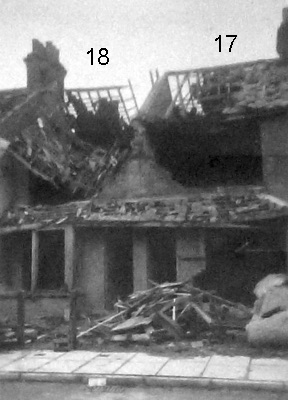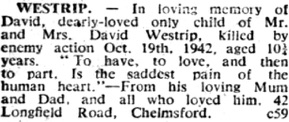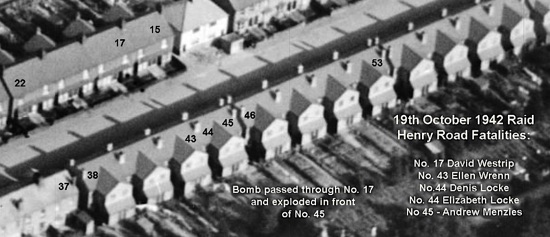David Alan Westrip was killed in October 1942 during a German attack at Hoffmann's bearings factory. A bomb struck his house in Henry Road, but did not explode, instead it passed through the house taking the air raid shelter in which he was sheltering across the street. The bomb exploded against a house on the opposite side of the road leaving David seriously injured. He died later in hospital.
David Alan WESTRIP, Civilian
Fatally injured during an air raid at Henry Road, Chelmsford. Aged 10
The picture left shows numbers and 18 and 17 Henry Road after the incident. David was left lying in the road with severe injuries to his legs which were badly crushed and broken. The man with him had a remarkable escape. He had been clinging onto the Morrison’s side curtain and had felt the curious sensation of flying through the air. After the explosion which rendered him unconscious he awoke to find himself among the wreckage of the houses on the west side of the road, and managed to get up suffering only from a cut on his back and bruises. Realising that he was not seriously hurt, he went to the aid of the boy who was then rushed to the Chelmsford & Essex Hospital.
Despite the valiant efforts of surgeons, who amputated both his legs, 10 year-old David was to die later in the day. He was a member of the 3rd Chelmsford Boys Brigade and a pupil at Trinity Road School.
David was buried at Chelmsford Borough Cemetery on 24th October 1942 (grave: 5522). The service was conducted by the Rev. T. H. Cullen, assisted by Mr. J. Feltham, and at the graveside the Last Post and Reveille were sounded by Sgt. Blackburn.
His mother was buried in the same grave when she died 15 years later.
160528

David was born in 1932, the only child of David Westrip (1898-1984) and Florence Kitty Westrip (nee Cranfield) (1901-1957).
He was a pupil at Trinity Road School in Chelmsford and a member of the 3rd Chelmsford Boys' Brigade.
In 1942 David was living at 17 Henry Road in Chelmsford, having moved there from 42 Longfield Road in Great Baddow. Henry Road was adjacent the massive Hoffmann's ball-bearings factory, a target for the German air
force throughout the war.
At 10.59 a.m. on 19th October 1942 a lone German Dornier Do 217E aircraft approached Chelmsford from the east at an altitude of around a thousand feet. Taking advantage of low cloud and poor visibility the aircraft dropped to around a 150 feet to make a bombing run on Hoffmann’s approximately along the line of one of the factory’s railway sidings. Almost immediately Hoffmann’s light machine defences opened up on the raider, but other army posts were unable to fire their Bofors guns at the aircraft because of its extremely low altitude - the gunners would have been firing in the direction of nearby buildings and people.
The Dornier was able to release two 500 Kg SC high explosive bombs on the works, with delayed actions of about twenty seconds, and it also machine gunned the ground. With its bombs released the aircraft turned north-eastwards, circled to the north of Chelmsford and made off due east towards the coast, apparently unscathed.
Those on the ground were not so fortunate. One of the bombs scored a direct hit on the factory. It penetrated the roof and exploded in the recently completed Cage & Assembly Shop, (part of Hoffmann’s ‘C factory’, to the north of Rectory Lane). Four people died as a result of that bomb, six others were seriously injured, and 43 men and 16 women slightly hurt.
The other bomb deflected off the factory’s roof passed struck the rear of 17 Henry Road, a house to the west of the factory. The bomb entered the house’s back bedroom and in the process it demolished the room’s side and back walls and window. It then passed into the middle bedroom, demolishing its window and external wall, before continuing through the bedroom floor and the ceiling of the rear downstairs room. From there it passed through the partition wall into the front downstairs room, where it struck the side of the property’s Morrison shelter.
David had just taken cover inside the shelter, whilst a man, believed to have been his father, was just about to get inside too. The latter was holding onto the Morrison’s side curtain when it was struck with such force that the shelter and its occupants were carried though the front of the house at high speed.
In the process the front bay window and wall below it were completely torn out by the bomb and shelter, which then travelled some sixty feet across the road and into the front garden of 45 Henry Road. There the bomb finally detonated and the shelter was hurled back towards number 17 by the explosion. Its frame finished up upsidedown, twisted and mangled in the road (pictured below left after being removed from the road after the raid), whilst its top plate was flung up into the front bedroom of number 17.


